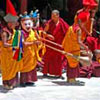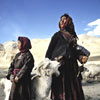
Life Style of Ladakh People :
The people of Ladakh are generally quite different from those of the rest of India.The faces and physique of the Ladakhis, and the clothes they wear, are more similar to those of Tibet and Central Asia than of India. In eastern and central Ladakh, today’s population seems to be mostly of Tibetan origin. Further west, in and around Kargil, the people’s appearance suggests a mixed origin.The exception to this generalisation is the Arghons, a community of Muslims in Leh, originated as a result of marriages between local women and Kashmiri or Central Asian merchants. They exhibit a marked dominance of the Indo-Aryan trait in their physique and appearance, though culturally they are not different from the rest of the Ladakhis.
ART AND CRAFT :
The tradition of artistic craftsmanship in Ladakh is not as well developed as in neighbouring Kashmir, and most of the luxury articles are obtained through imports.
The exception is the village of Chiling, about 19 km up the Zanskar River from Nimo, where a community of metal workers carry on their ancestral profession, working with silver, brass and copper. These are said to be the descendants of artisans brought from Nepal during the mid-17th century to build one of the gigantic Buddha – images at Shey. They produce exquisite items for domestic and religious use, such as tea and chang pots, teacup-stands and lids, hookah-bases, ladles, bowls and occasionally, silver chortens for temples and domestic shrines.
Items of everyday use such as cooking pots and bowls, as well as agricultural implements are supplied by local blacksmiths (gara). They also make the large and ornate iron stoves seen in kitchens of the Ladakhi homes. Craftsmanship in general has not developed beyond the production of everyday items for domestic use. Pattu, the rough, warm, woollen material used for clothing is made from locally produced wool, spun by women on drop-spindles, and woven by traditional weavers on portable looms that are set up in the winter sunshine or under the shade of a tree in summer. Baskets, for the transport of any kind of burden, are woven out of willow twigs or a particular variety of grass. Woodwork is confined largely to the production of pillars and carved lintels for the houses and the low carved tables or Chog-tse that are a feature of every Ladakhi living room.
Many such items, including newly introduced varieties, are available in the Government Handicrafts Centre at Leh. There you can find, in addition to traditional objects, a few special items like pure pashmina shawls, rough compared with those produced in Srinagar, and carpets with Tibetan designs. Similar carpets can also be purchased at the Tibetan Refugee Centre, Choglamsar. The Handicrafts Centre also has a department of thangka painting. These icons on cloth are executed in accordance with strict traditional guidelines handed down the generations.
In the same tradition are the mural paintings in the monasteries, where semi-professionals, both monks and laymen, toil to keep the walls decorated with images symbolising various aspects of Buddhism. The skill of building religious statues is also not extinct. The gigantic image of Maitreya Buddha was installed in Thiksey Gompa as recently as the early 1980s.






